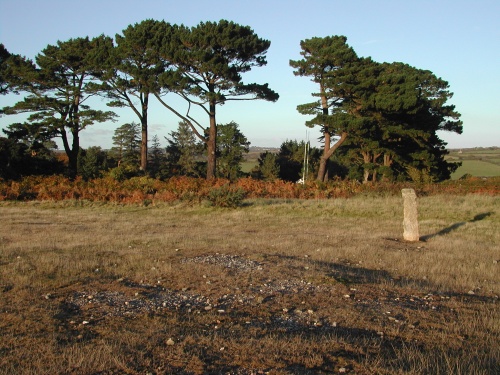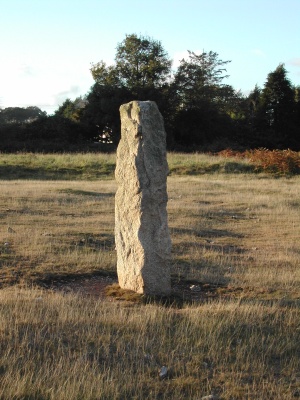|
|
|||||||||
|
|
 |
|
Wheal Gorland in 1811 by William Phillips This old account of Wheal Gorland mine in Cornwall provides a rare and fascinating insight into the mineralogy of this old mine and the occurrence of minerals. At the time this account was written Liroconite was often generally referred to as an 'Arseniate of Copper'. The main subject of this account was Cuprite, termed 'Red Oxyd of Copper', and Pharmacosiderite, known as 'Arseniated Iron'. However, it does provide valuable and almost unique information on where the Copper Arsenates such as Liroconite were found. This account was published in the Transactions of the Geological Society, London 1:23 - 37 in the year 1811. |
 |
||
|
Bawden's Shaft, Wheal Gorland, Gwennap, Cornwall, Oct 2003 |
||
|
A Description of the Red Oxyd of Copper , the production of Cornwall, and of the Varieties in the form of its Crystal, with Observations on the Lodes which principally produced it; and on the Crystallization of the arseniated Iron. By William Phillips, Member of the Geological Society. The Mine called Huel Gorland, in the parish of Gwennap and county of Cornwall, is in a hill whereon is situated the town of St.Day, to which it is immediately contiguous eastward. In this mine there are seven lodes; one of tin, the others of copper; but as only three of the latter have produced the red oxyd of copper, it will not be important further to notice the others. These three lodes are known by the names of the North Lode, the Great Gossan Lode, and the Muttrell Lode. The latter, is that noticed by the Count de Bournon, as having produced the arseniate of copper, in a paper published in the Transactions of the Royal Society, in which he has so ably and scientifically described that mineral. In the North Lode which runs eighty fathoms north of the Great Gossan Lode, the red oxyd of copper was occasionally found with fluate of lime; though, compared with the quantities produced by the other two lodes, very sparingly. The Great Gossan Lode averages about four feet in width; the Muttrell Lode about three feet. The former runs eight degrees from the north of the west, meeting the latter, which runs four degrees from the south of the west, at a certain point, whence they run together for about fifty fathoms. The united lode is about twelve feet wide, and takes a direction nearly east. The underlay of these lodes is north; the Great Gossan Lode about two feet, the Muttrell Lode one foot ten inches, and the united lode one foot nine inches, in the fathom. The two lodes are about thirty-seven fathoms apart at fifty fathoms west of the point where they meet; from which place they have been worked, respectively, the Great Gossan Lode about two hundred and thirty fathoms, and the Muttrell Lode seventy fathoms, at the adit level. They afterwards run on together about forty fathoms in Huel Gorland mine, and further east form a valuable part of the rich and extensive mine called Huel Unity. Huel Gorland is in granite. In that part of the mine where the two lodes are separate, the adit is fifty fathoms from the surface, but after they have run together some distance, it is only forty fathoms, the descent of the hill being towards the east. The adit being nearer on a level than the surface of the country, it is, therefore, in noticing the depths of different parts of a mine, most correct to date from the adit level, as is the practice of miners. The depths hereafter given are so dated. In the two lodes, the red oxyd of copper was found under very different circumstances. In the Great Gossan Lode it occurred principally between the sixty-six and eighty-six fathom levels, in considerable quantity, often in well-defined crystals, and occasionally intermingled with native copper. Above it, the lode abounded with fluate of lime, frequently very solid, and so pure, that they, whose business it is to assay copper for the miner and the purchaser, preferred it as a flux to that of any other mine. Among this fluate of lime, and sometimes intimately mingled with it, considerable quantities of the yellow copper ore were found, and some arsenical pyrites containing 4 or 5 per cent of copper, though comparatively little of that gossan, which, as will presently be noted, constituted the greater part of the Muttrell Lode; nor was the arseniate of copper discovered in any part of this lode, west of the junction of it with the Muttrell Lode. The Muttrell Lode is one, to which no other lode hitherto discovered in the County of Cornwall bears any analogy. Throughout almost the whole length of its working, but particularly in that part, above, below, and in which was discovered the great deposit of red oxyd of copper, with the beautiful varieties of which this mine has enriched the cabinet of the mineralogist, this lode abounded in an ochreous substance, frequently accompanied by quartz, which from its appearance may be termed an argillaceous oxyd of iron; and which, sometimes for a considerable length and depth, constituted alone the great body of the lode. This substance is always considered by the miner as an indication of neighbouring riches; it is technically called gossan, and is denominated kindly, or very kindly, in proportion to the darkness of its hue, and the looseness of its texture. Through this gossan they sunk in the Muttrell Lode forty-six fathoms, and almost as many above the adit, before they arrived at any considerable quantity of the red oxyd of copper, which afterwards continued through a space ten fathoms in depth, and about six fathoms in length; being disposed in bunches, the largest and richest of which were about fifteen feet in length, by as many in depth. In this lode, the red oxyd of copper was accompanied occasionally by vitreous copper ore, black oxyd of copper, arseniate of copper, arsenical pyrites, quartz, and fluate of lime. Native copper also occurred in considerable quantities, generally in contact with the red oxyd, and more or less intermingled with it. It was sometimes remarkably brilliant, and occasionally occurred regularly crystallized. There were however considerable masses of the red oxyd unaccompanied by any of the above substances, hollow within, and presenting, on being broken, perfect and varied crystallizations. From the depth of fifity-six fathoms, the search for this mineral was continued for forty fathoms lower, with but little success; bunches of a few tons in weight, and smaller quantities were occasionally discovered, but these became less frequent; so that, at ninety-six fathoms under the adit, the further working of this lode was abandoned. At this depth one part of the vein consisted only of gossan, and was six feet in width, forty fathoms from which it narrowed to three feet, and was there composed of yellow copper ore and quartz. Further east than the principal body of the red oxyd of copper, and at different depths in the Muttrell Lode; that is, nearer the junction of it with the Great Gossan Lode, were found the interesting varieties of the arseniate of copper, and occasionally that substance which in the paper before alluded to has been described by the Count de Bournon, and by him called Cupreous Arseniate of Iron . These substances were also found in considerable abundance at the line of junction of the two lodes, and in its immediate neighbourhood eastward, at various depths, but with scarcely a trace of the red oxyd of copper until the depth of fifty-six fathoms, at which place this mineral also was found in the Gossan before described, occasionally intermingled with arseniate of copper. The latter occurred, besides, in great abundance in the same lode in Huel Unity; indeed, I believe it is to that part of the united lodes which passes through this mine, that mineralogists are chiefly indebted for the fine varieties of the arseniate of copper. That beautiful mineral, the cubic arseniate of iron, was also found at and near the junction of the Great Gossan and Muttrell Lodes; but occurred in greatest quantity in the latter, thirty fathoms west of the junction, about the adit level; being forty-six fathoms higher, though perhaps not immediately above the part in which the first discovery of the red oxyd took place. The cubic arseniate of iron was also found in the Gossan before described.
William Phillips continues with a description of the cubic arseniate of iron, and of the red oxyd of copper. We are very grateful to Mike Merry from Cornwall & Devon Mineral Specimens for providing a copy of this old document |
|
|
||||||||||||||||
|
Copyright (C) 2003-2008 David Aubrey-Jones. All rights reserved. No part of this Web site and its contents may be reproduced in any form without the written permission of the author. |
|
[Liroconite] [Rarity] [Discovery] [Habit & Form] [Descriptions] [Locations] [Cornish Minerals] [Links] [About us] |

